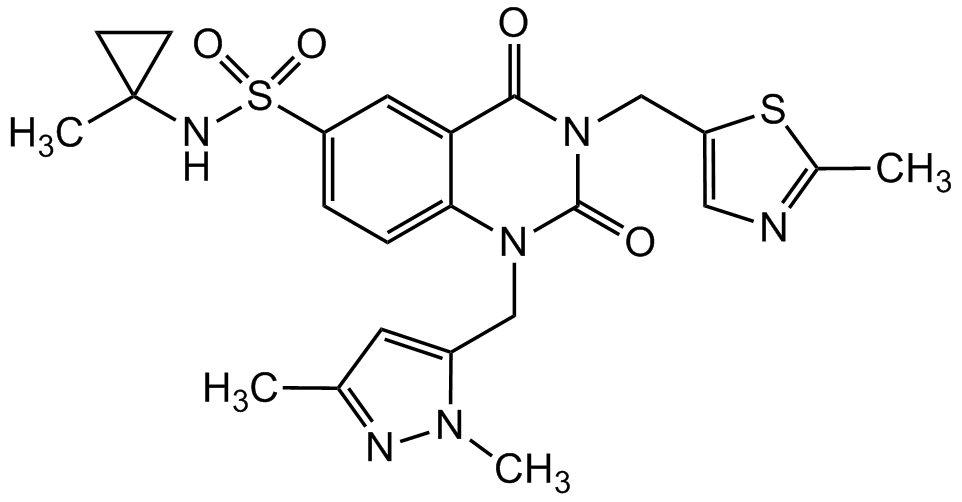PARG Inhibitor PDD00017273
| Code | Size | Price |
|---|
| AG-CR1-3646-M001 | 1 mg | £65.00 |
Quantity:
| AG-CR1-3646-M005 | 5 mg | £160.00 |
Quantity:
Prices exclude any Taxes / VAT
Overview
Regulatory Status: RUO
Shipping:
-20°C
Storage:
-20°C
Images
Documents
Further Information
Alternate Names/Synonyms:
PARG Inhibitor Compound 4; 1-[(2,5-Dimethylpyrazol-3-yl)methyl]-N-(1-methylcyclopropyl)-3-[(2-methylthiazol-5-yl)methyl]-2,4-dioxo-quinazoline-6-sulfonamide
Appearance:
White to off-white solid.
CAS:
1945950-21-9
EClass:
32160000
Form (Short):
liquid
Handling Advice:
Keep cool and dry.
InChi:
InChI=1S/C23H26N6O4S2/c1-14-9-16(27(4)25-14)12-28-20-6-5-18(35(32,33)26-23(3)7-8-23)10-19(20)21(30)29(22(28)31)13-17-11-24-15(2)34-17/h5-6,9-11,26H,7-8,12-13H2,1-4H3
InChiKey:
IFWUBRBMMNTBRZ-UHFFFAOYSA-N
Long Description:
Chemical. CAS: 1945950-21-9. Formula: C23H26N6O4S2. MW: 514.6. Human poly(ADP-ribose) glycohydrolase (PARG) inhibitor for in vitro studies. Inhibits human recombinant PARG enzymes (IC50=26nM) and PARG in cell assays (IC50=37nM). Inactive against related glycohydrolases ARH3 and PARP1s (IC50>30µM). Showed no cytotoxicity (IC50>30µM). Poly(ADP ribose) glycohydrolase (PARG) is a critical component in the repair of single strand DNA breaks and therefore a target in cancer cells. PARG counteracts the function of the ARTD family of poly(ADP ribose) polymerases (known as PARPs) by efficiently catalysing the hydrolysis of O-glycosidic linkages of ADP-ribose polymer, thereby reversing the effects of PARPs.
MDL:
MFCD30536372
Molecular Formula:
C23H26N6O4S2
Molecular Weight:
514.6
Package Type:
Vial
Product Description:
Human poly(ADP-ribose) glycohydrolase (PARG) inhibitor for in vitro studies. Inhibits human recombinant PARG enzymes (IC50=26nM) and PARG in cell assays (IC50=37nM). Inactive against related glycohydrolases ARH3 and PARP1s (IC50>30µM). Showed no cytotoxicity (IC50>30µM). Poly(ADP ribose) glycohydrolase (PARG) is a critical component in the repair of single strand DNA breaks and therefore a target in cancer cells. PARG counteracts the function of the ARTD family of poly(ADP ribose) polymerases (known as PARPs) by efficiently catalysing the hydrolysis of O-glycosidic linkages of ADP-ribose polymer, thereby reversing the effects of PARPs.
Purity:
>98% (HPLC)
SMILES:
O=C(C1=CC(S(NC2(CC2)C)(=O)=O)=CC=C1N3CC4=CC(C)=NN4C)N(CC5=CN=C(C)S5)C3=O
Solubility Chemicals:
Soluble in DMSO (10mg/ml), methanol or acetonitrile (1mg/ml).
Transportation:
Non-hazardous
UNSPSC Category:
Protein Kinase Modulators
UNSPSC Number:
12352200
Use & Stability:
Stable for at least 2 years after receipt when stored at -20°C.
References
First-in-class chemical probes against poly(ADP-ribose) glycohydrolase (PARG) inhibit DNA repair with differential pharmacology to Olaparib: D.I. James, et al.; ACS Chem. Biol. 11, 3179 (2016) | Specific killing of DNA damage-response deficient cells with inhibitors of poly(ADP-ribose) glycohydrolase: P. Gravells, et al.; DNA Repair 52, 81 (2017)



